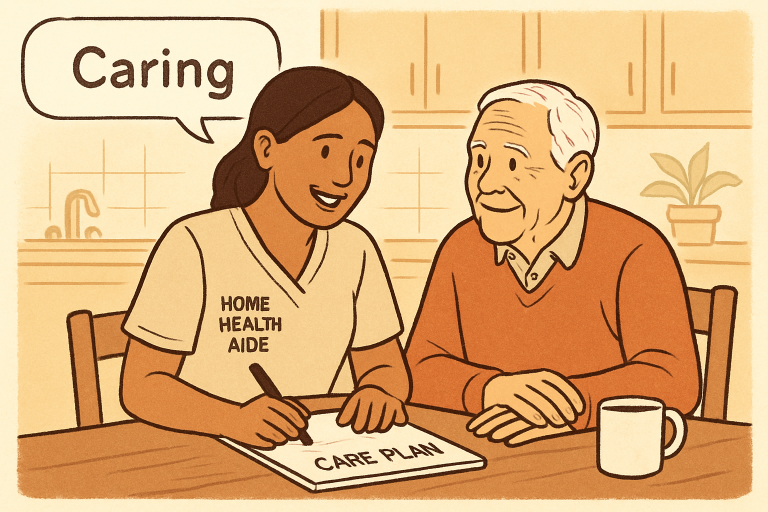Key Takeaways
- Personalized care plans tailored to individual needs improve outcomes and satisfaction.
- Integrating technology, such as smart home devices and AI tools, enhances safety and efficiency.
- Creative staffing models and comprehensive training programs address workforce challenges.
- Community engagement and cooperative models strengthen support networks and resource accessibility.
Home health aides are often the unsung heroes, delivering hands-on support so that aging or recovering individuals can continue living safely and comfortably in their homes. The role of a home health aide goes beyond basic physical support; it also involves building trust, preserving dignity, and fostering a sense of independence in clients. With growing demand for effective in-home care, exploring creative and innovative methods has become crucial to meeting the evolving needs of those receiving care and the professionals providing it.
Leveraging fresh approaches—ranging from personalized plans and high-tech support to improved training—raises care standards and enhances day-to-day experiences. As clients’ needs vary greatly, customized caregiving and community-driven solutions keep everyone connected and empowered. Empowering the modern home health aide with new tools and methods supports a higher quality of life for both caregivers and those they serve.
Personalized Care Plans
At the core of exceptional home health care are thoughtfully tailored care plans. Every individual brings a unique set of life experiences, medical histories, and personal preferences. As such, effective planning begins with a comprehensive assessment to understand each client’s physical and emotional needs, daily routines, cultural background, and long-term goals.
- Assessment and Collaboration: Home health aides, clients, and families work together to set achievable goals based on personal priorities—ranging from maintaining mobility to pursuing creative hobbies or social activities.
- Continuous Re-evaluation: Regular discussion and adjustment of care plans are crucial, allowing for quick response to changes in health status, lifestyle, or personal wishes.
This person-centered model ensures respect, autonomy, and the highest possible quality of life, even as needs evolve.

Leveraging Technology
Modern technology is revolutionizing the way home health aides provide care. Integrating digital tools and smart devices enhances both safety and efficiency in the home environment.
- Smart Home Integration: Devices such as automated lighting, fall detection sensors, and medication dispensers help prevent accidents and support day-to-day independence.
- Artificial Intelligence: AI-powered virtual assistants can guide clients through daily routines, offer engaging brain games, and ease feelings of loneliness—especially important for those who may not have regular visitors.
- Telehealth and Remote Monitoring: Wearable technology and app-based health tracking let caregivers and family members remotely monitor vital signs, while real-time telehealth visits keep healthcare providers in the loop.
These integrated solutions not only improve response times and peace of mind but also free caregivers from repetitive tasks, letting them focus on what matters most: meaningful human connection.
Innovative Staffing Models
Meeting the growing need for home health services requires new thinking in recruitment, scheduling, and staff support. Innovative staffing models offer powerful answers:
- Worker Cooperatives: Granting aides ownership in care agencies can lead to higher wages, greater job satisfaction, and lower turnover rates. Success stories, such as Cooperative Care in Wisconsin, prove that shared ownership increases commitment and morale.
- Flexible Work Arrangements: Creative shift scheduling, job sharing, and part-time opportunities help balance caregiver work-life demands. These changes attract a diversifying workforce, encourage longevity, and reduce burnout.
Such forward-thinking models improve employment quality for caregivers, ultimately benefiting clients through more consistent care and stronger relationships.
Comprehensive Training Programs
Professional growth and skill development are essential to maintaining high standards in home health care. Ongoing training ensures aides are equipped with up-to-date best practices for both basic and advanced care needs.
- Continuous Learning: Workshops and e-learning sessions provide new information on topics like infection control, dementia care, and effective communication.
- Emotional Support: Training should include self-care resources and tools to recognize signs of caregiver stress and burnout, encouraging long-term career satisfaction.
- Clear Career Paths: Structured advancement programs motivate aides to pursue additional certification or leadership roles, recognizing commitment and building a sense of purpose.
By nurturing professional development, agencies lay a foundation for skilled, compassionate care and employee retention.
Community Engagement and Cooperative Models
Home health isn’t only about one-on-one support; it’s about building strong networks for those who need them most. Connection with civic groups, faith-based organizations, and local businesses extends resources and creates a holistic safety net for clients and caregivers alike.
- Community Partnerships: Collaborations can allow easier access to nutritious meals, transportation, exercise programs, and counseling services, removing barriers to healthy living.
- Shared Decision-Making: Cooperative models encourage both caregivers and clients to contribute ideas for service improvements, resource allocation, and shared goals.
An engaged community fosters a sense of belonging and resilience, opening doors to creative solutions and improved well-being for everyone involved.
By embracing highly personalized care, state-of-the-art technology, innovative workforce solutions, ongoing education, and robust community ties, the home health aide profession stands ready to meet the challenges of today—and tomorrow. These creative strategies empower caregivers and enrich the lives of those who depend on them, crafting a compassionate, responsive, and resilient care environment for all.
